棉花病害
棉花田中常见的病虫害及防治

棉花田中常见的病虫害及防治棉花作为一种重要的经济作物,广泛种植于全球各地。
然而,在生长期间,棉花田常常受到各种病虫害的侵袭。
这些病虫害不仅会对棉花的产量和品质造成严重影响,还可能导致经济损失。
因此,科学有效地防治棉花田中的病虫害显得尤为重要。
本文将针对棉花田中常见的病虫害进行详细介绍,并提供相应的防治方法。
一、棉花黄萎病棉花黄萎病是一种由真菌引起的病害,主要表现为棉花叶片黄化、萎蔫、凋谢等症状。
该病害常在湿热环境中发生,对棉花产量和品质造成极大威胁。
防治措施:1. 合理调控水肥管理,保持适宜的湿度和通风条件,减少病菌的繁殖;2. 通过合理轮作和间作,破坏病菌的生物循环,减少病源的传播;3. 使用抗病品种,提高棉花的抗病能力;4. 进行适时的防治药剂喷洒,减轻病害的发生。
二、棉铃虫棉铃虫是棉花田中常见的害虫之一,它以棉花的花蕾和幼果为食,严重影响棉花的产量和质量。
防治措施:1. 机械除虫:定期在棉田中进行机械除虫,减少害虫的数量;2. 生物防治:引入棉铃虫的天敌,如寄生蜂,进行生物防治;3. 使用化学农药:在严重虫害的情况下,可以使用合适的化学农药进行防治。
但是要注意使用方法和剂量,以免对环境和人体造成伤害。
三、棉花黑致病菌病棉花黑致病菌病是由黑致病菌引起的病害,主要危害棉花的叶片和苞片。
受害部位会产生黑褐色的坏疽斑点,严重影响棉花的光合作用和营养吸收。
防治措施:1. 选用抗病品种,提高棉花的抗病能力;2. 加强田间管理,及时清除病叶和病残体,减少病菌的繁殖;3. 进行适时的防治药剂喷洒,控制病害的扩散。
四、棉铃虫棉蚜联防棉铃虫和棉蚜是棉花田中常见的两种害虫。
它们同时出现时会产生协同效应,对棉花造成更大的破坏。
防治措施:1. 喷洒具有防治双害虫作用的化学农药;2. 引入天敌,如寄生蜂和捕食性昆虫,进行生物防治;3. 采用粘虫板和黄板进行监测和防治,减少害虫的数量;4. 加强田间管理,营造良好的生态环境,提高棉花的自然抗病能力。
棉花常见病害及防治技术
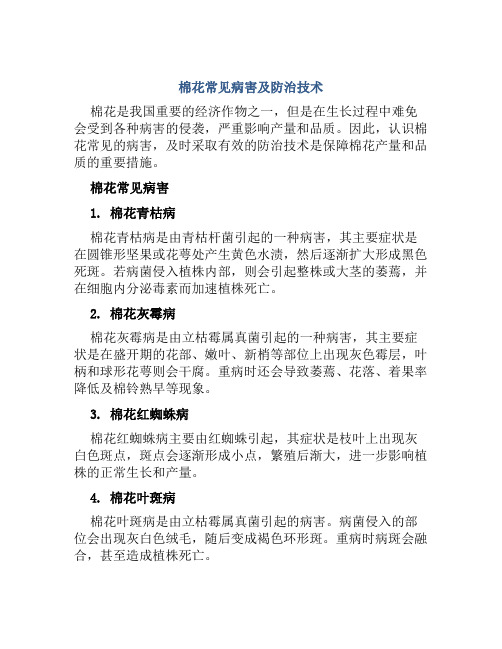
棉花常见病害及防治技术棉花是我国重要的经济作物之一,但是在生长过程中难免会受到各种病害的侵袭,严重影响产量和品质。
因此,认识棉花常见的病害,及时采取有效的防治技术是保障棉花产量和品质的重要措施。
棉花常见病害1. 棉花青枯病棉花青枯病是由青枯杆菌引起的一种病害,其主要症状是在圆锥形坚果或花萼处产生黄色水渍,然后逐渐扩大形成黑色死斑。
若病菌侵入植株内部,则会引起整株或大茎的萎蔫,并在细胞内分泌毒素而加速植株死亡。
2. 棉花灰霉病棉花灰霉病是由立枯霉属真菌引起的一种病害,其主要症状是在盛开期的花部、嫩叶、新梢等部位上出现灰色霉层,叶柄和球形花萼则会干腐。
重病时还会导致萎蔫、花落、着果率降低及棉铃熟早等现象。
3. 棉花红蜘蛛病棉花红蜘蛛病主要由红蜘蛛引起,其症状是枝叶上出现灰白色斑点,斑点会逐渐形成小点,繁殖后渐大,进一步影响植株的正常生长和产量。
4. 棉花叶斑病棉花叶斑病是由立枯霉属真菌引起的病害。
病菌侵入的部位会出现灰白色绒毛,随后变成褐色环形斑。
重病时病斑会融合,甚至造成植株死亡。
5. 棉花萎枯病棉花萎枯病是由枯萎菌引起的一种病害。
植株出现萎缩、黄化、枯死等症状,导致产量大幅降低。
因此,要及时发现并采取有效的防治措施。
棉花常见病害防治技术1. 农业技术防治农业技术防治是防治棉花病害的有效方法之一,包括以下几个方面:•种植优良品种。
选用抗病性较强的棉花品种,增强棉花的抗病能力。
•加强田间管理。
合理密度栽培,及时排除病部,注意通风,合理施肥,规范农时等,保证棉田整洁、畅通、干燥,减少病害发病。
•采用合理的轮作制度。
轮作与间作改善土壤环境,减轻病原菌的污染,增加棉花对病菌的耐受性。
2. 生物防治生物防治是利用有益菌、细菌、真菌、病毒等微生物控制棉花病害的一种方法。
常用的生物防治方法有:•枯草芽孢杆菌防治棉花青枯病。
如在病发初期通过为茬切断病源,及时清除病株、墒情整改和灰覆盖等,可以有效降低病害发生的风险。
棉花主要病害及其防治措施

棉花主要病害及其防治措施棉花是我国重要的经济作物之一,也是重要的纺织原料。
但是,在棉花的生长过程中,会受到各种病害的影响,导致产量减产,甚至死亡。
为了保证棉花的正常生长,我们需要采取一系列的防治措施。
本文将详细介绍棉花主要病害及其防治措施。
一、棉花黑臭病棉花黑臭病是由真菌感染引起的病害。
患病的棉花会出现黑色的坏疽区域,并伴随着剧烈的恶臭。
这种病害不但会导致棉花的减产,还会使得棉纤维变得粗糙,从而降低了棉花的商业价值。
防治措施:1、农户应该选择高质量的种子并注意种植密度,使棉花之间的距离充足,从而降低病菌的传播。
2、定期在棉田中施入有机肥料,增加土壤的肥力,从而提高棉花的抗病能力。
3、注意灌溉管理,避免棉花在处于长期的湿润状态。
因为真菌病菌在潮湿的环境中繁殖速度会更快。
4、如果已经发现了病害,可以使用药剂进行喷洒,如咪唑酮和甲霜灵等。
二、棉花花斑病棉花花斑病是由病毒感染引起的一种病害。
患病的棉花会在种子发芽后出现类似黄烟的症状,严重的话会导致棉花的减产,并降低纤维的品质。
防治措施:1、首先,选择健康的种子,并在种植前进行热处理。
2、棉花斑病主要是通过蚜虫传播的,所以应该对蚜虫进行控制。
常见的药剂包括:吡虫啉、氧乐果、吡丙灵等。
3、及时清除田间荒杂物,减少蚜虫的滋生。
三、棉花霜霉病棉花霜霉病是由真菌感染引起的一种病害,通常发生在潮湿的环境中。
患病的棉花会出现灰白色的霉斑并且难以修复,从而降低棉花的产量和质量。
防治措施:1、应该注意灌溉管理,减少棉花暴露在湿润环境中的时间。
2、及时清除田间废弃物,减少霉菌的滋生。
3、选用抗霉菌的优质种子,并增加作物的免疫能力。
4、喷洒霉菌杀菌剂,如氢氧化钠等。
总的来说,保持棉花田地的卫生环境,提高棉花的自然免疫能力,以及及时使用合适的药剂进行喷洒,是保证棉花健康的有效措施。
只有这样,才能保证棉农们获得更好的经济效益和生活质量。
棉花主要病虫害防治技术措施
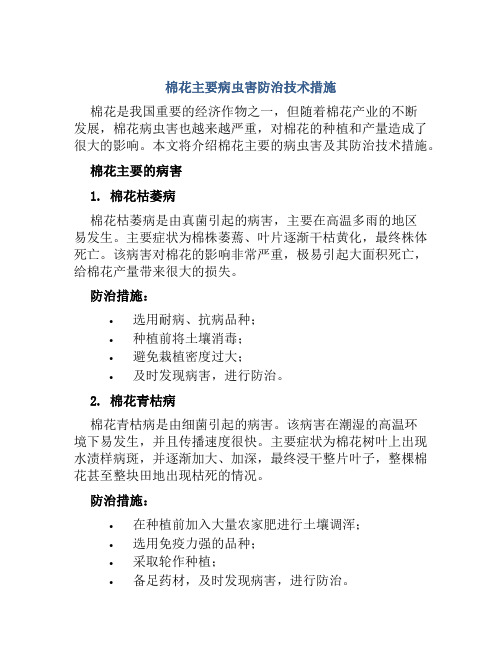
棉花主要病虫害防治技术措施棉花是我国重要的经济作物之一,但随着棉花产业的不断发展,棉花病虫害也越来越严重,对棉花的种植和产量造成了很大的影响。
本文将介绍棉花主要的病虫害及其防治技术措施。
棉花主要的病害1. 棉花枯萎病棉花枯萎病是由真菌引起的病害,主要在高温多雨的地区易发生。
主要症状为棉株萎蔫、叶片逐渐干枯黄化,最终株体死亡。
该病害对棉花的影响非常严重,极易引起大面积死亡,给棉花产量带来很大的损失。
防治措施:•选用耐病、抗病品种;•种植前将土壤消毒;•避免栽植密度过大;•及时发现病害,进行防治。
2. 棉花青枯病棉花青枯病是由细菌引起的病害。
该病害在潮湿的高温环境下易发生,并且传播速度很快。
主要症状为棉花树叶上出现水渍样病斑,并逐渐加大、加深,最终浸干整片叶子,整棵棉花甚至整块田地出现枯死的情况。
防治措施:•在种植前加入大量农家肥进行土壤调浑;•选用免疫力强的品种;•采取轮作种植;•备足药材,及时发现病害,进行防治。
3. 棉花红根腐病棉花红根腐病是由真菌引起的病害,主要在潮湿环境下发生。
它能够侵染棉花根部,导致棉根内部组织受损、水分代谢障碍,引起棉花生长停滞,严重时植株死亡。
防治措施:•种植前进行土壤消毒;•选用优良品种,增强棉花的抗病能力;•避免田地积水;•给棉花适量施肥,保持棉田通风透气。
棉花主要的虫害1. 棉铃虫棉铃虫是棉花上最常见的为害虫之一。
它主要吸食棉花幼苗和嫩叶,造成棉花幼苗萎缩、生长缓慢和大片叶片枯黄凋萎死亡等现象。
防治措施:•采取机械方法手摘;•病叶软化处理,以防卵的寄生;•给棉花打药防治,使用残留期短、毒性小的杀虫剂。
2. 棉花叶螨棉花叶螨是一种微小的危害棉花的虫类,它们主要侵害棉花的叶片。
叶面上出现小白斑、黄斑,叶片变形脱落,在严重的情况下会破坏棉花的光合作用。
防治措施:•选择免疫力强的品种,提高棉花的防御能力;•采用轮作种植,减少叶螨寄生的机会;•及时发现,并使用易溶解型的杀虫剂进行防治。
棉花常见病害识别与防治

·土肥植保
棉花十技
3.炭疽病 棉花幼苗出土前棉花从播种到收获都可能遭受病原微生物的侵染,每年因病棉花常见病害识别与防治
落。
④紫红型。
子叶或真叶组织湖南省棉花科学研究所 李彩红
土肥植保·
硼大白菜新根少、根颈膨大,
个别根端有小瘤状突起;植株
,叶片严重萎缩粗
糙,结球小而坚硬。
为防止大白菜缺硼,可将图1缺硼幼叶叶柄的裂伤 图3 缺硼大白菜植株矮小
图2 缺硼叶柄出现群聚褐色污斑
铃壳及棉瓤上布满淡红色粉状物,粉层较红腐病厚而成块状,略带黄色。
病铃铃壳不能开裂,纤维干腐。
8.黑果病 棉铃感病,铃壳进行种子包衣或药剂拌种,增强
棉花抗逆性。
2.田间管理 选择地势高、
无渍无涝、无枯黄萎病发生的地
块种植。
通过深翻土壤、增施有
3.科学施药 使用20%甲基
立枯磷或30%噁霉灵,进行土壤
消毒。
直播棉出苗后20天内是
棉苗易受病原菌侵染的时期,应
密切关注天气,阴雨天前后及时。
棉花常见病虫害

注重环保和社会责任
加强国际合作和交流
在防治棉花病虫害的过程中,需要注重环保 和社会责任,采取可持续的防治措施,保护 生态环境和人类健康。
棉花病虫害的防治是一个全球性的问题,需 要加强国际合作和交流,分享经验和信息, 共同应对这一挑战。
THANKS
感谢观看
需要加强技术研究和推广
针对棉花病虫害的防治,需要加强技术研究和推广,以提高防治效果和减少对环境的影响 。
研究展望
加强病虫害监测和预警
探索新的防治手段
未来需要加强对棉花病虫害的监测和预警, 通过科学预测和预防,减少病虫害的发生和 影响。
防治棉花病虫害需要探索新的手段,例如生 物防治、物理防治等,以减少化学农药的使 用量和副作用。
精整土地
清除田间杂草、残株落叶,并深翻 土地,以减少越冬虫源。
科学施肥
使用腐熟的有机肥,并合理搭配氮 、磷、钾肥,以增强棉花的抗病性 。
生物防治措施
利用天敌
保护和利用天敌,如瓢虫、草蛉等,以控制害虫的种群数量 。
生物农药
使用生物农药,如Bt乳剂、苦参碱等,对病虫害进行防治。
化学防治措施
化学农药
使用高效、低毒、低残留的化学农药,如敌百虫、吡虫啶等,对病虫害进行 防治。
生活习性
盲蝽象成虫喜欢在棉花植株上栖 息和产卵,以刺吸式口器吸取植 物汁液。
危害症状
盲蝽象的若虫和成虫均可危害棉 花,造成叶片卷曲、褪色、蕾铃 脱落等问题,严重影响棉花的产 量和品质。
03
棉花病虫害的综合防治
农业防治措施
种植抗病品种
选择种植对病虫害抵抗力强的品种 。
合理轮作
避免连作,最好进行三年以上的轮 作,以降低病虫害的发生率。
棉花主要病虫害防治

棉花主要病虫害防治棉花是一种重要的经济作物,但由于棉花生长周期长、病虫害较多,使得棉花生产过程中常常受到病虫害的侵害,导致产量下降,影响农民的收入。
棉花病虫害的防治对于棉花的高产高质生产具有非常重要的意义。
棉花主要的病虫害包括红蜘蛛、棉铃虫、棉若虫、白粉病、黄萎病等。
这些病虫害的侵害会导致棉花叶片、果铃和茎秆出现不同程度的损伤,影响植株生长和产量,同时还会影响棉花品质。
科学合理地预防和控制棉花病虫害,对于提高棉花产量和质量,实现稳定增产具有重要意义。
(一)白粉病白粉病是一种常见的棉花病害,主要为霉菌引起的真菌病害。
白粉病多发生在潮湿多雨的环境中,受病害侵害的棉花叶片上会出现白色的霉层,严重时会导致叶片枯黄脱落。
白粉病严重影响了叶片的光合作用,影响了棉花生长和产量。
防治方法:1.选择抗病品种:选育抗病品种是预防白粉病的重要手段之一,选择抗病品种对于减少病害的发生具有明显的效果。
2.合理密植:适当的密植可以减少叶片之间的通风和透光,降低病害发生的机率。
3.合理施肥:施用适量的钾肥和磷肥,增强棉花的抗病能力。
4.药剂防治:及时使用杀菌剂进行预防和控制,选择安全、有效的药剂,及时进行喷雾处理。
5.灭菌处理:病害严重时,可采用灭菌处理方法,对于已受到严重侵害的叶片进行剪除或者焚烧处理,减少病害的传播。
(二)黄萎病黄萎病是由真菌引起的一种病害,主要发生在潮湿多雨的环境中。
黄萎病会导致棉花的根系受损,影响植株的正常生长和发育,严重时会导致植株死亡。
防治方法:1.旋作休耕:在黄萎病发生的地块,不要连续种植棉花,可以改种其他作物,以减少病害的发生。
2.合理施肥:适当施用大量的有机肥和磷肥,增强植株的抗病能力。
3.用药防治:黄萎病的病原菌存活在土壤中,在发病严重的地块,可选用药物进行土壤消毒处理。
4. 种植抗病品种:选用抗病品种进行种植,减少病害的发生。
(三)灰霉病(一)红蜘蛛红蜘蛛是棉花的主要害虫之一,主要危害棉花叶片。
棉花主要病虫害防治
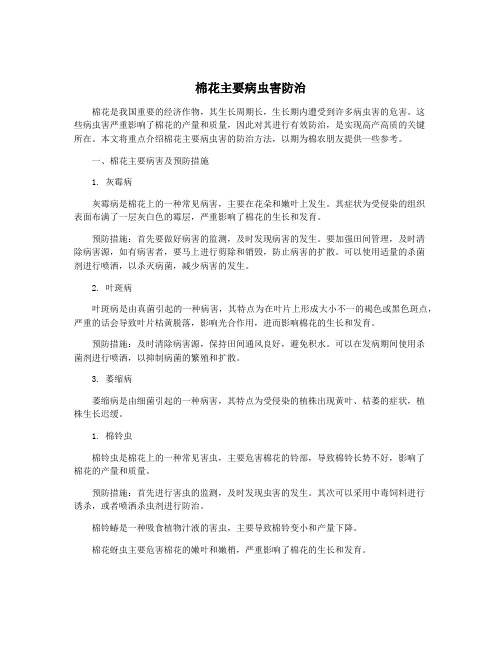
棉花主要病虫害防治棉花是我国重要的经济作物,其生长周期长,生长期内遭受到许多病虫害的危害。
这些病虫害严重影响了棉花的产量和质量,因此对其进行有效防治,是实现高产高质的关键所在。
本文将重点介绍棉花主要病虫害的防治方法,以期为棉农朋友提供一些参考。
一、棉花主要病害及预防措施1. 灰霉病灰霉病是棉花上的一种常见病害,主要在花朵和嫩叶上发生。
其症状为受侵染的组织表面布满了一层灰白色的霉层,严重影响了棉花的生长和发育。
预防措施:首先要做好病害的监测,及时发现病害的发生。
要加强田间管理,及时清除病害源,如有病害者,要马上进行剪除和销毁,防止病害的扩散。
可以使用适量的杀菌剂进行喷洒,以杀灭病菌,减少病害的发生。
2. 叶斑病叶斑病是由真菌引起的一种病害,其特点为在叶片上形成大小不一的褐色或黑色斑点,严重的话会导致叶片枯黄脱落,影响光合作用,进而影响棉花的生长和发育。
预防措施:及时清除病害源,保持田间通风良好,避免积水。
可以在发病期间使用杀菌剂进行喷洒,以抑制病菌的繁殖和扩散。
3. 萎缩病萎缩病是由细菌引起的一种病害,其特点为受侵染的植株出现黄叶、枯萎的症状,植株生长迟缓。
1. 棉铃虫棉铃虫是棉花上的一种常见害虫,主要危害棉花的铃部,导致棉铃长势不好,影响了棉花的产量和质量。
预防措施:首先进行害虫的监测,及时发现虫害的发生。
其次可以采用中毒饲料进行诱杀,或者喷洒杀虫剂进行防治。
棉铃蝽是一种吸食植物汁液的害虫,主要导致棉铃变小和产量下降。
棉花蚜虫主要危害棉花的嫩叶和嫩梢,严重影响了棉花的生长和发育。
预防措施:可以采用拾虫或人工捕捉的方法进行控制,或者喷洒杀虫剂进行防治。
另外要多加重视田间的清洁,加强田间管理,避免虫害的发生和传播。
棉花病虫害的鉴别和防治方法
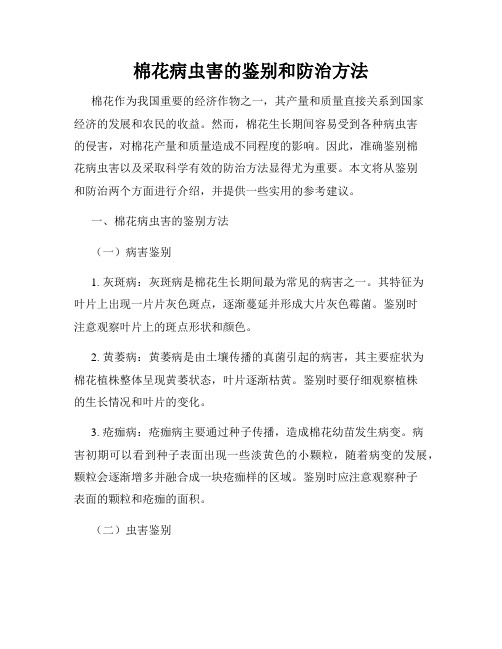
棉花病虫害的鉴别和防治方法棉花作为我国重要的经济作物之一,其产量和质量直接关系到国家经济的发展和农民的收益。
然而,棉花生长期间容易受到各种病虫害的侵害,对棉花产量和质量造成不同程度的影响。
因此,准确鉴别棉花病虫害以及采取科学有效的防治方法显得尤为重要。
本文将从鉴别和防治两个方面进行介绍,并提供一些实用的参考建议。
一、棉花病虫害的鉴别方法(一)病害鉴别1. 灰斑病:灰斑病是棉花生长期间最为常见的病害之一。
其特征为叶片上出现一片片灰色斑点,逐渐蔓延并形成大片灰色霉菌。
鉴别时注意观察叶片上的斑点形状和颜色。
2. 黄萎病:黄萎病是由土壤传播的真菌引起的病害,其主要症状为棉花植株整体呈现黄萎状态,叶片逐渐枯黄。
鉴别时要仔细观察植株的生长情况和叶片的变化。
3. 疮痂病:疮痂病主要通过种子传播,造成棉花幼苗发生病变。
病害初期可以看到种子表面出现一些淡黄色的小颗粒,随着病变的发展,颗粒会逐渐增多并融合成一块疮痂样的区域。
鉴别时应注意观察种子表面的颗粒和疮痂的面积。
(二)虫害鉴别1. 蚜虫:蚜虫是棉花生长期间最为常见的虫害之一,其特征为叶片上出现一群长约2-4毫米的小虫,通常为黄绿色。
鉴别时注意观察虫害部位和虫体的形态。
2. 棉铃虫:棉铃虫是棉花生长期间的重要害虫之一,对棉花的危害较大。
其特征为在棉铃内产卵和取食,导致棉铃变小、变形或干脆不结铃。
鉴别时要仔细观察棉铃的形态和内部情况。
3. 棉红蜘蛛:棉红蜘蛛是通过吸食棉花上的汁液而危害棉花的害虫。
其特征为叶片上出现一些微小的红色动物,其数量较多时会形成蜘蛛网状的结构。
鉴别时要注意观察叶片上的红色动物和网状结构。
二、棉花病虫害的防治方法(一)病害防治1. 优质种子:选用优质的棉花种子,可以提高植株的抗病性,减少病害的发生。
2. 合理施肥:科学施肥可以提高棉花的免疫力,减少病害的发生。
合理施肥应根据土壤的养分状况和作物需求进行,避免过量或不足施肥。
3. 轮作休闲:合理安排棉花的轮作休闲,可以有效降低病害的发生。
棉花主要病虫害防治技术措施

汇报人:日期:•棉花病虫害概述•棉花主要病害及防治措施•棉花主要虫害及防治措施•棉花病虫害综合防治技术•棉花病虫害防治的未来趋势棉花病虫害概述棉花病虫害是指在棉花的生长过程中,由于受到有害生物的影响,导致棉花植株出现生理机能障碍,从而影响棉花的正常生长发育和产量、品质。
棉花病虫害主要分为病害和虫害两大类。
病害包括真菌性病害、细菌性病害和病毒性病害等,虫害包括蚜虫、红蜘蛛、棉铃虫等。
棉花病虫害的定义与分类分类定义棉花病虫害会导致植株生长受阻,叶片枯萎、脱落,甚至整株死亡。
生长受阻产量下降品质下降病虫害会导致棉花结铃减少,皮棉产量下降。
病虫害会导致棉花纤维品质下降,影响棉纺织品的质量。
030201棉花病虫害对棉花生长的影响棉花病虫害防治是保障农业生产安全的重要措施,对于稳定棉花生产、提高农民收入具有重要意义。
保障农业生产安全有效的病虫害防治可以改善棉花的品质,提高棉纺织品的质量,增强我国棉纺织业的竞争力。
提高棉纺织品质量合理使用农药,减少对环境的污染,保护生态环境,实现农业可持续发展。
保护生态环境棉花病虫害防治的重要性棉花主要病害及防治措施棉花枯萎病是一种严重的土传病害,通常在苗期至蕾期发生。
病株叶片变黄、萎蔫,叶脉变褐,叶片边缘或叶尖出现褐色坏死。
症状识别选用抗病品种,合理轮作,加强田间管理,如合理施肥、控水等。
化学防治可选用内吸性杀菌剂进行灌根处理。
防治方法棉花黄萎病也是一种常见的土传病害,通常在现蕾期至结铃期发生。
病株叶片边缘或中间出现黄色斑块,叶片逐渐变黄、萎蔫。
防治方法同样选用抗病品种,合理轮作,加强田间管理。
化学防治可选用杀菌剂进行叶面喷施处理。
症状识别棉花炭疽病是一种真菌性病害,可在苗期至成熟期发生。
病株叶片出现圆形或近圆形的红褐色斑点,边缘呈紫褐色。
防治方法选用抗病品种,加强田间管理。
化学防治可选用杀菌剂进行叶面喷施处理。
此外,及时清除病残体也是有效的防治措施之一。
棉花主要虫害及防治措施生活习性棉铃虫是一种鳞翅目害虫,以幼虫蛀食棉花蕾和铃,影响棉花的正常发育和品质。
棉花病虫害种类
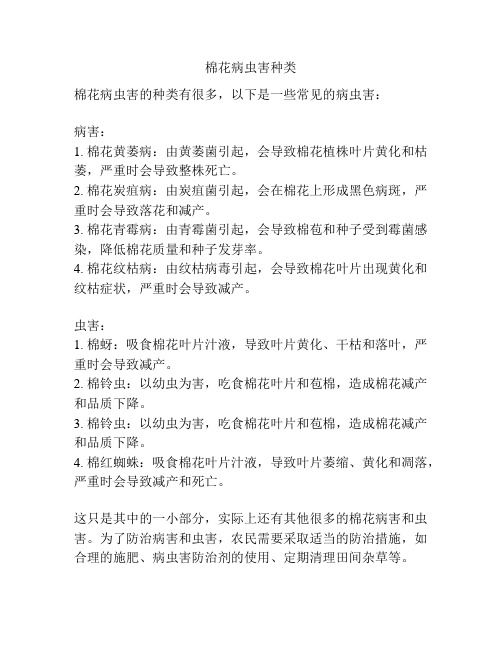
棉花病虫害种类
棉花病虫害的种类有很多,以下是一些常见的病虫害:
病害:
1. 棉花黄萎病:由黄萎菌引起,会导致棉花植株叶片黄化和枯萎,严重时会导致整株死亡。
2. 棉花炭疽病:由炭疽菌引起,会在棉花上形成黑色病斑,严重时会导致落花和减产。
3. 棉花青霉病:由青霉菌引起,会导致棉苞和种子受到霉菌感染,降低棉花质量和种子发芽率。
4. 棉花纹枯病:由纹枯病毒引起,会导致棉花叶片出现黄化和纹枯症状,严重时会导致减产。
虫害:
1. 棉蚜:吸食棉花叶片汁液,导致叶片黄化、干枯和落叶,严重时会导致减产。
2. 棉铃虫:以幼虫为害,吃食棉花叶片和苞棉,造成棉花减产和品质下降。
3. 棉铃虫:以幼虫为害,吃食棉花叶片和苞棉,造成棉花减产和品质下降。
4. 棉红蜘蛛:吸食棉花叶片汁液,导致叶片萎缩、黄化和凋落,严重时会导致减产和死亡。
这只是其中的一小部分,实际上还有其他很多的棉花病害和虫害。
为了防治病害和虫害,农民需要采取适当的防治措施,如合理的施肥、病虫害防治剂的使用、定期清理田间杂草等。
棉花常见病虫害

防治棉花黄萎病的关 键是采取合理的农业 措施,如轮作、选用 抗病品种、加强田间 管理等。此外,可以 使用化学药剂进行土 壤处理和喷洒发病植 株。
棉花害虫概述
棉花害虫的分类和识别
分类
棉花害虫可分为根部害虫、茎部害虫、叶部害虫和花部害虫,如根腐病、蚜 虫、红蜘蛛等。
识别
不同害虫有不同的形态特征和生活习性,识别害虫主要依靠经验判断和观察 。
生物防治
利用天敌如瓢虫、草蛉等捕食红蜘蛛,控 制其数量。
化学防治
使用杀螨剂如阿维菌素、丙溴磷等,进行 喷雾防治。
物理防治
使用黄板诱杀或灯光诱杀等物理方法,减 少红蜘蛛的繁殖和危害。
棉花病害的综合防治
农业防治措施
选用抗病品种
选择对病虫害抵抗力强的 棉花品种,从源头上减少 病害的发生。
合理轮作
避免连作,减少病原菌的 积累和繁殖,每三年进行 一次轮作。
棉花害虫对棉花的危害
01
02
03
破坏植物组织
害虫啃食棉花的叶子、茎 杆和花蕾,导致植物组织 缺损,影响光合作用和开 花结果。
传播病害
某些害虫可以传播病害, 如蚜虫可以传播病毒病, 对棉花生长造成更大危害 。
降低产量
由于害虫的破坏和传播病 害,会导致棉花减产和品 质下降。
棉花害虫的生态习性和发生规律
《棉花常见病虫害》
2023-10-27
contents
目录
• 棉花病害概述 • 棉花真菌病害 • 棉花害虫概述 • 棉花蚜虫病害 • 棉花红蜘蛛病害 • 棉花病害的综合防治
棉花病害概述
棉花病害的定义和分类
棉花病害是指棉花在生长过程 中受到病原微生物的侵袭,导 致棉花出现异常生理生化反应
棉花病虫害种类

棉花病虫害种类1. 引言棉花是世界上最重要的经济作物之一,也是全球纺织品工业的主要原料之一。
然而,棉花生产过程中常常受到各种病虫害的威胁,这些病虫害会给棉花产量和质量带来严重影响。
因此,了解棉花病虫害种类及其特征对于科学防治和提高棉花产量至关重要。
2. 棉花病害种类2.1 灰霉病灰霉病是棉花上常见的真菌性病害之一,由灰霉菌引起。
该病在湿润环境下易发生,主要侵染棉铃、叶片和茎部。
患病部位出现灰白色霉层,并逐渐扩展。
患部叶片变黄、凋萎,并最终褪色脱落。
预防和控制方法包括合理施肥、增加通风、适当间隔植株、定期清除田间杂草,并使用合适的杀菌剂进行喷洒。
2.2 黄萎病黄萎病是由黄萎菌引起的一种严重的真菌性病害。
该病主要侵染棉花根系,导致根系腐烂和枯萎。
患病棉花表现为叶片发黄、枯死,整株植株生长停滞。
预防和控制黄萎病的方法包括选择抗性品种、合理施肥、控制灌溉水分和适度间休等。
2.3 立枯病立枯病是棉花上常见的真菌性病害之一,由立枯菌引起。
该病主要侵染棉花茎部和果铃,导致植株生长停滞、叶片变黄、凋落,并最终导致整株植株死亡。
预防和控制立枯病的方法包括选择抗性品种、适当间隔植株、增加通风和光线等。
3. 棉花虫害种类3.1 棉铃虫棉铃虫是棉花上最常见的虫害之一,幼虫主要以棉花的嫩叶和茎部为食,严重影响棉铃发育。
成虫主要吸取棉花汁液,并传播病毒。
预防和控制棉铃虫的方法包括合理施肥、适时采摘和清除病株等。
3.2 棉红蜘蛛棉红蜘蛛是一种重要的害虫,主要侵染棉花叶片。
其吸取植株汁液导致叶片黄化、枯萎,并且会产生大量的网丝覆盖植株。
预防和控制棉红蜘蛛的方法包括合理施肥、增加通风、适时喷洒杀虫剂等。
3.3 刺吸式害虫刺吸式害虫主要包括刺吸式口器的介壳虫和白粉虱等。
这些害虫通过刺吸植株汁液导致叶片黄化、卷曲,并可引起传播病毒。
预防和控制刺吸式害虫的方法包括定期清除田间杂草、适时喷洒杀虫剂等。
4. 结论棉花病虫害是棉花生产中常见的问题,对棉花产量和质量造成严重影响。
棉花主要病害及其防治措施

环境条件影响:气候、土壤等环境条件对病害发 生和发展具有重要影响。如高温高湿环境有利于 真菌病害的发生,干旱条件可能加重病毒病害的 发生。
在充分了解棉花病害的定义、影响、分类及发生 与发展的基础上,可以更有针对性地采取防治措 施,减少棉花生产过程中的病害损失,提高棉花 产量和品质。
02
棉花主要病害介绍
生长环境和病害发生情况的精确把握。
05
棉花病害防治的实践 与建议
农民在棉花病害防治中的角色与责任
病害识别
农民应学会识别棉花的常见病 害,如萎蔫病、黄萎病、疫病 等,以便及时发现并采取措施
。
农业管理
农民应加强田间管理,合理施 肥、浇水,提高棉花的抗病能 力。
病虫害防治
农民应定期巡查棉田,一旦发 现病害,及时使用合适的农药 进行防治,防止病害扩散。
病毒病害
由病毒引起的棉花病害,如棉花花 叶病毒病、棉花曲叶病毒病等。病 毒病害传播方式多样,防治难度较 大。
棉花病害的发生与发展
病原物传播:病原生物通过气流、水流、昆虫、 农事操作等途径传播,侵入棉花体内后,利用寄 主营养进行生长繁殖,破坏寄主正常生理功能, 导致病害发生。
寄主抗性:不同棉花品种对病害的抗性存在差异 ,抗性较弱的品种更容易感病,病害发生后病情 也更为严重。
严格遵守农药使用规定,控制用药量 、用药次数和用药间隔,以降低农药 残留和环境污染。
在病害发生初期,选用合适的农药进 行防治,如杀菌剂、杀虫剂等。注意 轮换用药,避免病原菌产生抗药性。
配合使用生物防治方法,如释放天敌 、施用生物农药等,以减少化学农药 的使用量,提高防治效果。
04
未来展望与技术研究
抗病育种技术研究与创新
1 2 3
棉花主要病虫害防治

棉花主要病虫害防治棉花是一种重要的经济作物,然而在其生长过程中会受到各种病虫害的威胁。
病虫害会严重影响棉花的产量和品质,因此必须采取有效的防治措施。
本文将从病虫害的种类、防治方法以及预防措施等方面进行详细讨论。
一、棉花的主要病虫害1. 病害棉花的病害主要有黄萎病、灰霉病、炭疽病等。
黄萎病是由黄萎病菌引起的,主要在幼苗期发生,病变部位由绿变黄,最终枯死。
灰霉病是由灰霉菌引起的,主要在开花期发生,叶片和花朵上出现灰色霉状物,严重时整棵植株都会枯萎。
炭疽病是由炭疽霉引起的,主要在果实上发生,出现黑色的圆形斑点。
2. 害虫棉花的害虫主要有棉铃虫、棉红蜘蛛、棉铃虫、棉 bollworm 等。
棉铃虫的幼虫主要危害棉花的生殖器官,造成棉铃和棉籽的减产,严重时会导致整株植株凋零。
棉红蜘蛛主要在高温干燥的条件下大量繁殖,造成叶片被吸干,从而影响光合作用。
棉蚜虫主要危害棉花的叶片,造成叶片变黄、卷曲、枯死等现象。
棉铃虫则会在棉铃内产卵,幼虫在里面进食,造成棉铃减产。
1. 化学防治化学防治是目前棉花病虫害防治的常用方法之一。
在发现病虫害初期,可以选择使用杀虫剂、杀菌剂等化学药剂进行防治。
常用的杀虫剂有敌敌畏、拟除虫菊酯等;常用的杀菌剂有万灵磷、百菌清等。
需要注意的是,化学防治要选择适量,严格按照药剂的使用说明,避免过量使用造成环境污染和药害。
2. 生物防治生物防治是一种环保、安全有效的病虫害防治方法。
常用的生物防治方法有释放天敌、使用有益微生物等。
释放天敌是指将天敌昆虫放入田间,让其捕食害虫,起到控制害虫数量的作用。
常用的天敌包括瓢虫、蚜虫敌、蜉蝣等。
有益微生物是指一些对有害微生物有杀灭或拮抗作用的微生物,可以通过制剂喷施或根部浇施等方式使用,起到防治病害的作用。
3. 栽培管理良好的栽培管理是预防棉花病虫害的重要环节。
首先要选择抗病虫害的品种种植,其次要注意合理的密植密肥,保证植株的健康生长,增强抗病能力。
同时要及时清除田间杂草,采取轮作休耕等措施,减少病虫害的繁殖和传播。
棉花主要病虫害的发生与防治研究
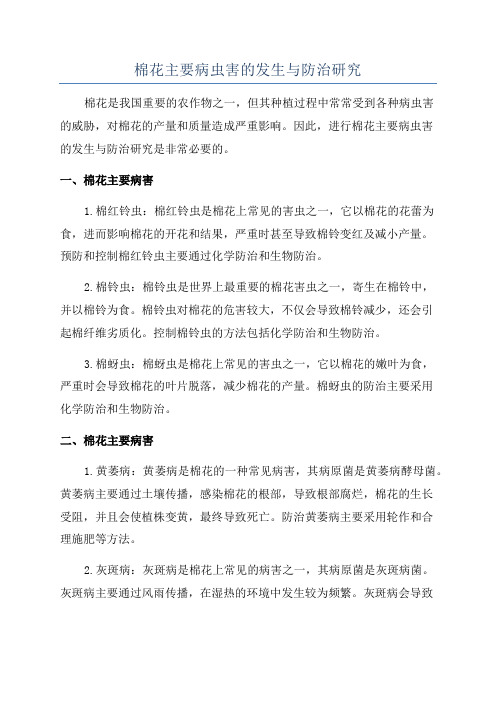
棉花主要病虫害的发生与防治研究棉花是我国重要的农作物之一,但其种植过程中常常受到各种病虫害的威胁,对棉花的产量和质量造成严重影响。
因此,进行棉花主要病虫害的发生与防治研究是非常必要的。
一、棉花主要病害1.棉红铃虫:棉红铃虫是棉花上常见的害虫之一,它以棉花的花蕾为食,进而影响棉花的开花和结果,严重时甚至导致棉铃变红及减小产量。
预防和控制棉红铃虫主要通过化学防治和生物防治。
2.棉铃虫:棉铃虫是世界上最重要的棉花害虫之一,寄生在棉铃中,并以棉铃为食。
棉铃虫对棉花的危害较大,不仅会导致棉铃减少,还会引起棉纤维劣质化。
控制棉铃虫的方法包括化学防治和生物防治。
3.棉蚜虫:棉蚜虫是棉花上常见的害虫之一,它以棉花的嫩叶为食,严重时会导致棉花的叶片脱落,减少棉花的产量。
棉蚜虫的防治主要采用化学防治和生物防治。
二、棉花主要病害1.黄萎病:黄萎病是棉花的一种常见病害,其病原菌是黄萎病酵母菌。
黄萎病主要通过土壤传播,感染棉花的根部,导致根部腐烂,棉花的生长受阻,并且会使植株变黄,最终导致死亡。
防治黄萎病主要采用轮作和合理施肥等方法。
2.灰斑病:灰斑病是棉花上常见的病害之一,其病原菌是灰斑病菌。
灰斑病主要通过风雨传播,在湿热的环境中发生较为频繁。
灰斑病会导致棉花的叶片上出现黑色斑点,严重时会引起叶片凋落。
防治灰斑病主要采用化学防治和合理施肥。
3.棉花霉病:棉花霉病是由霉菌感染引起的病害,主要通过空气、水、虫媒等途径传播。
棉花霉病会导致棉铃和纤维上生长霉菌,严重时会导致棉铃变黑、软、腐烂,棉纤维变黄、松散。
防治棉花霉病主要采用化学防治和病害监测。
为了有效防治棉花的病虫害,需综合运用化学防治、生物防治、物理防治和栽培措施等多种手段。
1.化学防治:可以通过喷洒农药来控制病虫害的发生,包括杀虫剂、杀菌剂等。
但要注意合理使用农药,避免对环境和生态系统造成污染。
2.生物防治:可以通过引入天敌或者利用生物农药来控制病虫害的发生。
例如,引入寄生虫或捕食者来控制害虫的数量,或者使用杀菌菌剂来控制病害菌的繁殖。
棉花苗期几种病害特征及防治技术
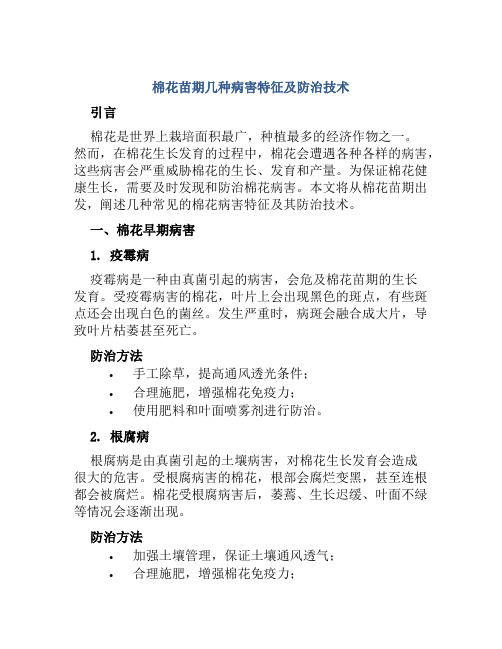
棉花苗期几种病害特征及防治技术引言棉花是世界上栽培面积最广,种植最多的经济作物之一。
然而,在棉花生长发育的过程中,棉花会遭遇各种各样的病害,这些病害会严重威胁棉花的生长、发育和产量。
为保证棉花健康生长,需要及时发现和防治棉花病害。
本文将从棉花苗期出发,阐述几种常见的棉花病害特征及其防治技术。
一、棉花早期病害1. 疫霉病疫霉病是一种由真菌引起的病害,会危及棉花苗期的生长发育。
受疫霉病害的棉花,叶片上会出现黑色的斑点,有些斑点还会出现白色的菌丝。
发生严重时,病斑会融合成大片,导致叶片枯萎甚至死亡。
防治方法•手工除草,提高通风透光条件;•合理施肥,增强棉花免疫力;•使用肥料和叶面喷雾剂进行防治。
2. 根腐病根腐病是由真菌引起的土壤病害,对棉花生长发育会造成很大的危害。
受根腐病害的棉花,根部会腐烂变黑,甚至连根都会被腐烂。
棉花受根腐病害后,萎蔫、生长迟缓、叶面不绿等情况会逐渐出现。
防治方法•加强土壤管理,保证土壤通风透气;•合理施肥,增强棉花免疫力;•使用生物有机肥、有机肥料、生防剂等方法进行防治。
3. 红蜘蛛红蜘蛛是一种常见的棉花害虫,常常在棉花苗期出现。
受红蜘蛛害后的棉花,叶片上会出现白点,随着害虫的繁殖,叶片变黄、变褐,最终导致叶片脱落。
防治方法•保持棉田卫生清洁,减少害虫栖息的环境;•采用药剂喷雾、拔草、埋膜等方法进行防治;•采用生物防治的方法,如使用三七粉、茶叶等进行防治。
二、棉花中期病害1. 叶斑病叶斑病是由真菌感染引起的病害,对棉花的生长、发育、产量等方面都会造成很大的影响。
受叶斑病害的棉花,叶面会出现圆形、椭圆形、不规则形的淡黄、灰白或浅褐色病斑,病斑边缘分明,常被一圈黑色边缘包围,中央部分变成透明。
防治方法•控制虫口密度,减少病毒传播;•加强种子消毒和育苗管理;•使用氯硫酸、硫酸亚铁、硫油浸种等方法进行防治。
2. 灰霉病灰霉病是一种由真菌感染引起的病害,常在湿度大、温度适宜的条件下发作。
- 1、下载文档前请自行甄别文档内容的完整性,平台不提供额外的编辑、内容补充、找答案等附加服务。
- 2、"仅部分预览"的文档,不可在线预览部分如存在完整性等问题,可反馈申请退款(可完整预览的文档不适用该条件!)。
- 3、如文档侵犯您的权益,请联系客服反馈,我们会尽快为您处理(人工客服工作时间:9:00-18:30)。
SYMPROMS
Young plants infected with Verticillium wilt show yellow leaves and stunting, and often die.
SYMPROMS
Often a single branch shows symptoms in the early stages of disease.
In addition, infurrow or hopper-box fungicides may be applied at planting. These materials are recommended in situations where seedling diseases are likely to occur.
disease called black root rot, is more common in other areas of the Cotton Belt, but it has recently been identified in Louisiana.
DISEASE CYCLE
Exact identification of the causal agent often requires isolation and laboratory identification. Except for T. basicola, these fungi are common in most cotton fields.
DISEASE CYCLE
Seedling diseases are more common under cool (temperatures below 65°F,18°C), wet conditions, but they may occur under any conditions that retard(延迟、阻碍) germination and early seedling growth.
Avoid compacted and crusted soils. Plant at the proper depth based on soil and moisture conditions and on raised seedbeds that adequately drain water.
The most obvious results of seedling disease include skips in the planting row caused by seed rot or death of seedlings.
SYMPTOM
Infected seedlings may be stunted and yellow. Dark, necrotic lesions on the stem may occur on one side of the stem, or as “wirestem” if they encircle the entire stem.
CHAPTER FIVE: COTTON DISEASE
§5-1 Seedling Diseases
1.SYMPTOM
Seedling diseases include the decay of seeds in the soil, death of seedlings before they emerge from the soil (preemergent damping off), death of seedlings after they emerge from the soil (post-emergent damping off) and lesions on the roots and lower stems of young plants.
CONTROL
Virtually all cottonseed that is purchased in Louisiana is commercially treated with a combination of fungicides to control seedling diseases.
小结
发生概况:分布? 危害? 病害识别:为害部位?发病时期?症状特点?
病原:Rhizoctonia solani Pythium spp. Fusarium spp.
病害发生发展规律:越冬、传播、入侵、发病及其 影响因素(气象、棉种质量、栽培措施、棉花品种、 栽培管理)?
综合防治:精选棉种;种子处理;农业防治;化学 防治
3.CONTROL
Management starts with the planting of high quality seed treated with fungicides.
Delaying planting until soils are 65°F or higher and favorable weather is forecast after planting will reduce the incidence of seedling diseases.
SYMPTOM
Black root rot causes the outer layer of the root to be black, but the inner tissue remains white.
Root and stem lesions that result in postemergent damping off are visible as dead, shriveled seedling in the planting row. Infected seedlings may survive, but are less vigorous, prone to(趋于) drought stress and may produce lower yields.
On some seedlings, the tap root(直根、主根) may be killed, causing a condition referred to as “nub-root” that results in a proliferation(增殖) of secondary roots above the point where the tap root is killed .
Rhizoctonia solani Pythium spp. Fusarium spp. are the primary organisms associated with seedling
disease in Louisiana. Thielaviopsis basicola, which causes a seedling
Poor seed quality, soil compaction(板结), herbicide injury and early season insect and nematode feeding all retard early season growth and increase seedling diseases.
§5-2 Cotton Verticillium Wilt
1.SYMPROMS
Leaves wilt and show interveinal yellowing before becoming necrotic. Light to dark brown vascular discoloration is prominent in the stem and branches. Defoliation and death of plants may occur.
SYMPTOM
Severe stand losses can result in yield losses directly or in losses imposed by replanting and delay in crop development.
Minor stand losses reduce the uniformity of the stand and result in problems associated with crop development, weeds and insect management.
CONTROL
Apply herbicides and fertilizers properly, and control early season insects and nematodes.
All of these practices will encourage rapid germination and seedling growth and allow the seedlings to escape infection.
The application of in-furrow or hopper-box fungicides is used to supplement seed treatment fungicides and is recommended in situations where seedling diseases are expected.
Nonlethal root and lower stem injury contribute to losses by reducing seedling growth and delaying plant development.
2.DISEASE CYCLE
